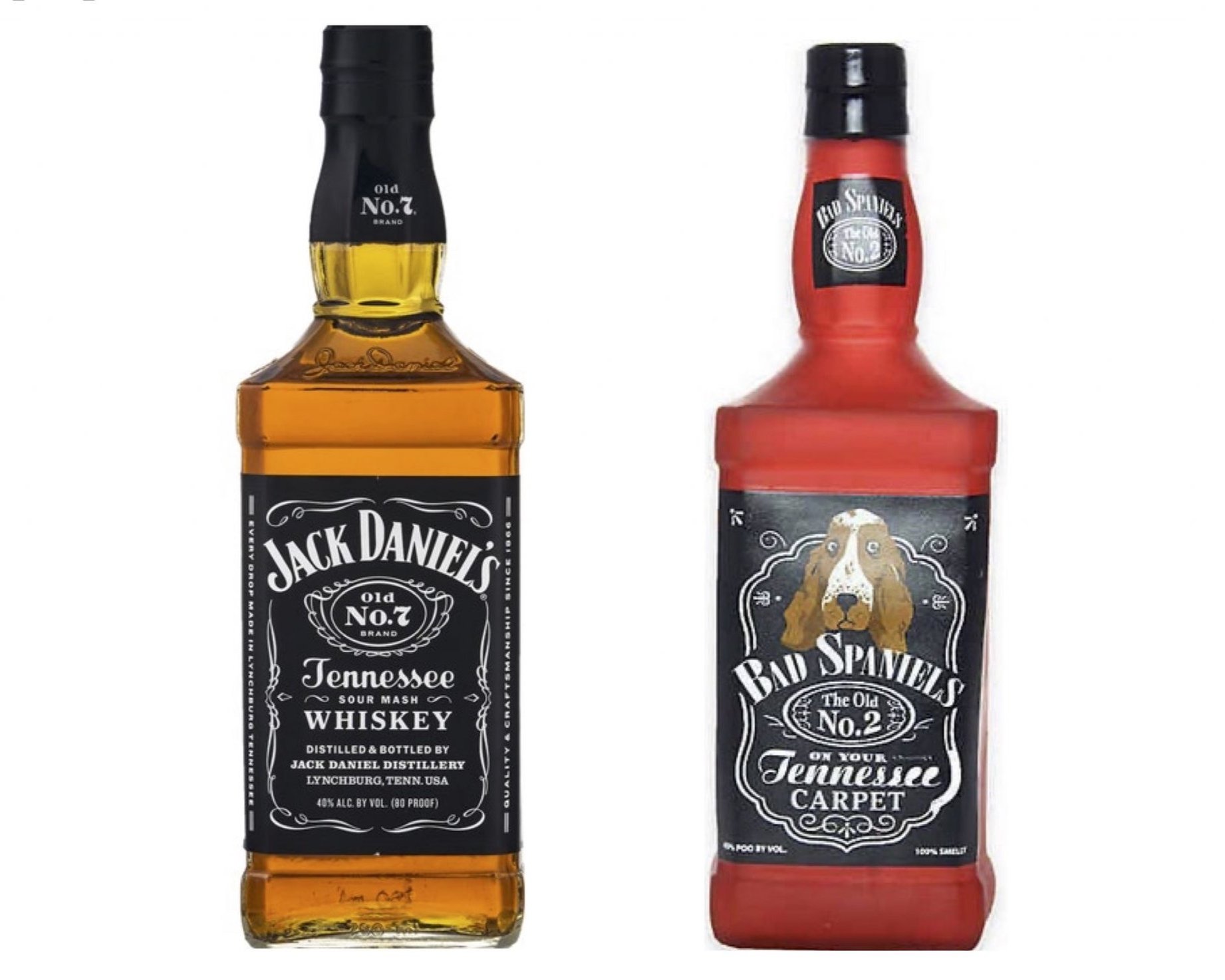Can Consumer Products be Expressive Works?
Exploring the Ninth Circuit’s unprecedented broadening of the Rogers test as a heightened standard for determining trademark infringement of expressive works and the potential implications of Supreme Court review of VIP Products LLC v. Jack Daniel’s Properties, Inc. in March 2023.
In an image released by the U.S. Supreme Court, a Jack Daniels bottle is shown alongside a Bad Spaniels dog toy.
On March 22, 2023, the United States Supreme Court heard oral arguments in VIP Products LLC v. Jack Daniel's Properties, Inc., a case regarding trademark disputes over the production of rubber dog toys meant to parody well-known beverages. The product in controversy made by VIP Products LLC (“VIP”) resembles a Jack Daniel’s bottle, but switches aspects of the logo to create a dog-related twist. Jack Daniel’s Properties, Inc. (“Jack Daniel’s”) alleges trademark dilution and infringement under the Lanham Act, which traditionally requires a finding that the use of the trademark is likely to cause consumer confusion. However, the Ninth Circuit concluded that the use of wordplay to alter the Jack Daniel’s logo conveys a humorous message that should be subject to the heightened standards for expressive work set forth in Rogers v Grimaldi. According to Rogers, the Lanham Act only applies to expressive, noncommercial work if the plaintiff can prove that the defendant’s use of the trademark is not artistically relevant to the underlying work or explicitly misleading to consumers.
There is a fine line between whether a product is considered an expressive, noncommercial work or simply a commercial good. Prior to VIP, the Rogers test only applied to works that were clearly expressive, such as movies, songs, and books. By extending the Rogers test to consumer products as well, the Ninth Circuit expanded the scope of the Rogers decision and created a lower bar for determining what constituted a creative expression. This unprecedented decision heightened protection for goods using a trademark in a humorous way, which could cause significant detriment to brands seeking to protect their trademarks. Now, any consumer goods that have even minimal artistic expression can escape liability under the Lanham Act if they do not fall under the narrow prongs of Rogers. According to Jack Daniel’s, this “paves the way for companies like respondent to unleash mass confusion in the marketplace.”
The Supreme Court is tasked with balancing First Amendment rights with the rights of trademark owners. Counsel for Jack Daniels not only argued that dog toys are not expressive works, but called for a complete rejection of the Rogers test because the likelihood of confusion test under the Lanham Act is broad enough to govern parodic goods. The Solicitor General also participated in oral arguments, similarly arguing on behalf of the Government that “First Amendment concerns do not justify displacing the Lanham Act’s likelihood of confusion standard when the alleged infringement occurs within the context of ‘expressive work.’” The main opponents of displacing the Rogers test include artists and movie companies, whose clearly expressive works have benefitted from Rogers protection. The Motion Picture Association filed an amicus brief arguing that Rogers should be upheld, but only as applied to artistic works and not consumer goods. Conversely, counsel for VIP contended that Rogers should be upheld and was correctly applied to dog toys, but also offered a modified multi-factor likelihood of confusion test that considers the parodic character of the product and its proximity to the mark.
Ultimately, the future of the trademark infringement analysis for expressive work is unclear. Rendering a decision for VIP would blur the boundaries between commercial and expressive goods and limit the abilities of trademark owners to have control over their marks. This has tremendous implications because it could frustrate the purpose of trademark law, which is to protect trademark owners and avoid harm to consumers. Companies would be free to infringe on protected trademarks as long as they incorporate some sense of humor in their products, and consumers would subsequently see a rise of such products in future markets.
It will be interesting to see how the Supreme Court’s decision will affect similar trademark cases, such as Hermes International v Rothschild, which was just decided in the Southern District of New York at the end of January but is likely to be appealed. Rothschild grapples with the same question of whether a work is purely commercial or an artistic expression but does so regarding NFTs in the virtual world. Although their expressive nature might seem facially obvious considering many NFTs are art pieces, brands use them to extend their product lines into the digital world. The jury concluded that NFT artwork should be seen as commercial goods rather than digital artworks. However, a potential Supreme Court ruling in favor of VIP, holding that consumer goods can be considered expressive and thus, fall within Rogers heightened standard, could support the future reversal of Rothschild.
Blog Cover Photo Attribution: LightFieldStudios

